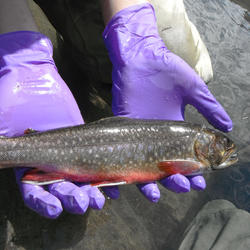Is White Sucker Tumor Prevalence in some Wisconsin Rivers Related to Environmental Contaminant Exposures or Other Factors?
Surface Tumor on White Sucker
Lip tumor diagnosed as a papilloma on a white sucker
The incidence of particular skin and liver tumors on white suckers collected from some Wisconsin rivers corresponded to the degree of urban development within the watershed. Further research is needed to understand the relationship between exposure to urban-sourced contaminants and the initiation, promotion, and potential for population-level effects of these tumors.

The health of white suckers (Catostomus commersonii) is monitored in the Great Lakes region and elsewhere to evaluate the adverse effects contaminants can have on wildlife. These fish are considered indicator species because they are native to the region, their habitat needs are well understood, they live and feed in direct contact with stream bottom sediments, and they are known to be sensitive to elevated levels of organic contaminants like polycyclic aromatic hydrocarbons (PAHs). The measurement of abnormalities in white suckers is one way to determine if exposure to sediment-associated contaminants and other risk factors are of sufficient magnitude to have adverse effects on fish populations.

During this 3-year study, U.S. Geological Survey (USGS) scientists measured tumor prevalence in white suckers in the Sheboygan River and Milwaukee Estuary. These sites have both been listed as Areas of Concern (AOCs) under the International Joint Commission Great Lakes Water Quality Agreement between the United States and Canada. This agreement designated AOCs as geographical locations where human activities have caused significant beneficial use impairment. White suckers were also collected from two non-AOC sites within the Great Lakes watershed to allow comparison to fish from sites with land-use characteristics that differed from those sampled within the AOCs. Skin and liver tumors were observed in white suckers at all sites. Testicular tumors were only observed in white suckers collected from the Sheboygan and Milwaukee Rivers. Both skin and liver tumors were significantly correlated with the age of the fish but not sex. The proportion of white suckers with liver tumors and a particular malignant skin tumor (squamous cell carcinoma) followed the same pattern as the proportion of urban land use in the watershed.
The findings demonstrate the prevalence of a wide array of tumors in white suckers that may be related to carcinogens in the sediment and water of these sites. Further research is needed to identify the most important initiators and promoters of these tumors. These findings can be used by resource managers to assess ongoing restoration activities intended to reduce wildlife exposures to contaminants.
This study was supported by the USGS Ecosystem Area's Environmental Health Program (Contaminant Biology and Toxic Substances Hydrology), Fisheries: Aquatic and Endangered Resources Programs, Cooperative Research Units Programs; and the Great Lakes Restoration Initiative.
Below are other science projects associated with this project.
Immunomodulation Science Team
Fishing and Hunting Integrated Science Team
Below are publications associated with this project.
Tumours in white suckers from Lake Michigan tributaries: Pathology and prevalence
Below are news stories associated with this project.
The incidence of particular skin and liver tumors on white suckers collected from some Wisconsin rivers corresponded to the degree of urban development within the watershed. Further research is needed to understand the relationship between exposure to urban-sourced contaminants and the initiation, promotion, and potential for population-level effects of these tumors.

The health of white suckers (Catostomus commersonii) is monitored in the Great Lakes region and elsewhere to evaluate the adverse effects contaminants can have on wildlife. These fish are considered indicator species because they are native to the region, their habitat needs are well understood, they live and feed in direct contact with stream bottom sediments, and they are known to be sensitive to elevated levels of organic contaminants like polycyclic aromatic hydrocarbons (PAHs). The measurement of abnormalities in white suckers is one way to determine if exposure to sediment-associated contaminants and other risk factors are of sufficient magnitude to have adverse effects on fish populations.

During this 3-year study, U.S. Geological Survey (USGS) scientists measured tumor prevalence in white suckers in the Sheboygan River and Milwaukee Estuary. These sites have both been listed as Areas of Concern (AOCs) under the International Joint Commission Great Lakes Water Quality Agreement between the United States and Canada. This agreement designated AOCs as geographical locations where human activities have caused significant beneficial use impairment. White suckers were also collected from two non-AOC sites within the Great Lakes watershed to allow comparison to fish from sites with land-use characteristics that differed from those sampled within the AOCs. Skin and liver tumors were observed in white suckers at all sites. Testicular tumors were only observed in white suckers collected from the Sheboygan and Milwaukee Rivers. Both skin and liver tumors were significantly correlated with the age of the fish but not sex. The proportion of white suckers with liver tumors and a particular malignant skin tumor (squamous cell carcinoma) followed the same pattern as the proportion of urban land use in the watershed.
The findings demonstrate the prevalence of a wide array of tumors in white suckers that may be related to carcinogens in the sediment and water of these sites. Further research is needed to identify the most important initiators and promoters of these tumors. These findings can be used by resource managers to assess ongoing restoration activities intended to reduce wildlife exposures to contaminants.
This study was supported by the USGS Ecosystem Area's Environmental Health Program (Contaminant Biology and Toxic Substances Hydrology), Fisheries: Aquatic and Endangered Resources Programs, Cooperative Research Units Programs; and the Great Lakes Restoration Initiative.
Below are other science projects associated with this project.
Immunomodulation Science Team
Fishing and Hunting Integrated Science Team
Below are publications associated with this project.
Tumours in white suckers from Lake Michigan tributaries: Pathology and prevalence
Below are news stories associated with this project.



